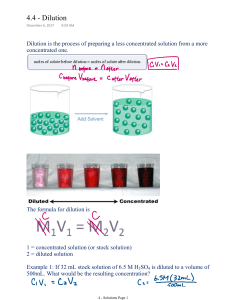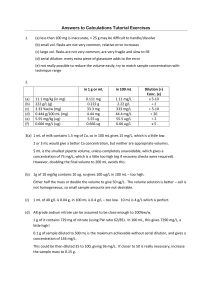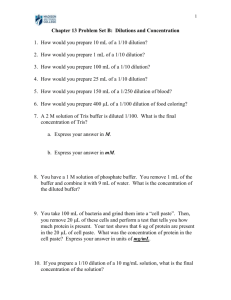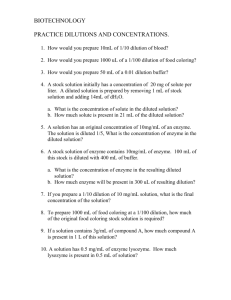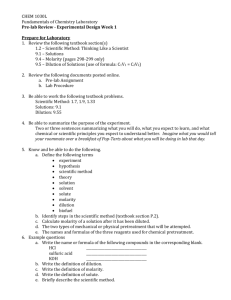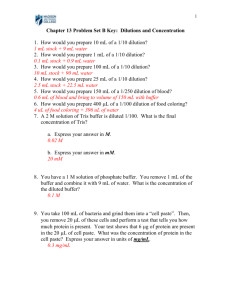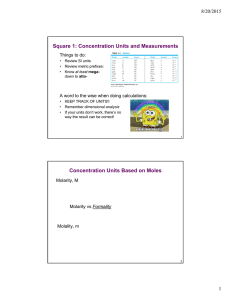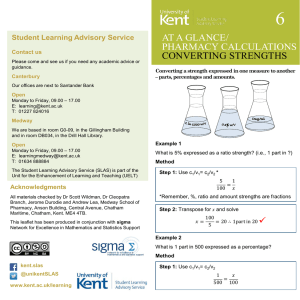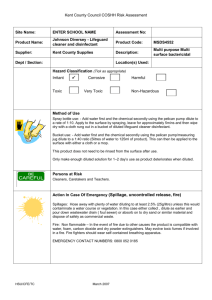11 AT A GLANCE/ PHARMACY CALCULATIONS
advertisement
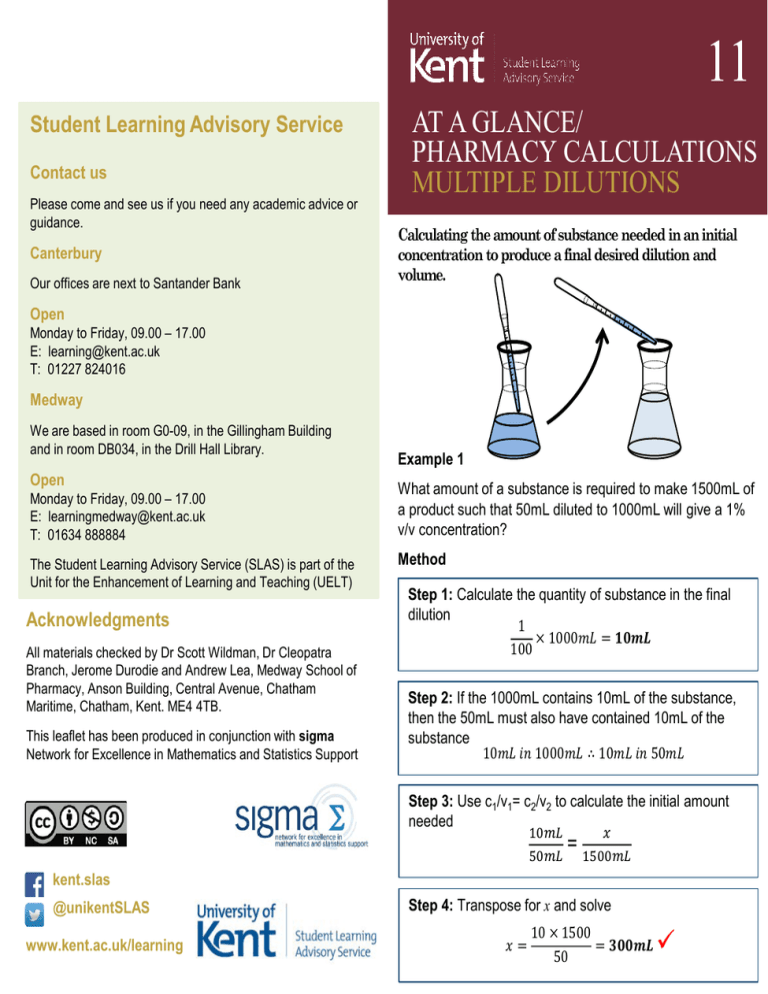
11 Student Learning Advisory Service Contact us Please come and see us if you need any academic advice or guidance. Canterbury Our offices are next to Santander Bank AT A GLANCE/ PHARMACY CALCULATIONS MULTIPLE DILUTIONS Calculating the amount of substance needed in an initial concentration to produce a final desired dilution and volume. Open Monday to Friday, 09.00 – 17.00 E: learning@kent.ac.uk T: 01227 824016 Medway We are based in room G0-09, in the Gillingham Building and in room DB034, in the Drill Hall Library. Open Monday to Friday, 09.00 – 17.00 E: learningmedway@kent.ac.uk T: 01634 888884 The Student Learning Advisory Service (SLAS) is part of the Unit for the Enhancement of Learning and Teaching (UELT) Acknowledgments All materials checked by Dr Scott Wildman, Dr Cleopatra Branch, Jerome Durodie and Andrew Lea, Medway School of Pharmacy, Anson Building, Central Avenue, Chatham Maritime, Chatham, Kent. ME4 4TB. This leaflet has been produced in conjunction with sigma Network for Excellence in Mathematics and Statistics Support kent.slas @unikentSLAS www.kent.ac.uk/learning Example 1 What amount of a substance is required to make 1500mL of a product such that 50mL diluted to 1000mL will give a 1% v/v concentration? Method Step 1: Calculate the quantity of substance in the final dilution 1 × 1000𝑚𝑚 = 𝟏𝟏𝒎𝒎 100 Step 2: If the 1000mL contains 10mL of the substance, then the 50mL must also have contained 10mL of the substance 10𝑚𝑚 𝑖𝑖 1000𝑚𝑚 ∴ 10𝑚𝑚 𝑖𝑖 50𝑚𝑚 Step 3: Use c1/v1= c2/v2 to calculate the initial amount needed 10𝑚𝑚 𝑥 = 50𝑚𝑚 1500𝑚𝑚 Step 4: Transpose for x and solve 𝑥= 10 × 1500 = 𝟑𝟑𝟑𝟑𝟑 50 Example 2 Step 4: Transpose and solve What weight of a substance is required to make 45mL of a product such that 3mL diluted to 100mL will give a 1 in 5000 concentration ? 𝑥= Method Step 1: Calculate the quantity of substance in the final dilution 1 × 100𝑚𝑚 = 𝟎. 𝟎𝟎𝒈 5000 Step 2: If the 100mL contains 0.02g of the substance, then the 3mL must also have contained 0.02g of the substance 0.02𝑔 𝑖𝑖 100𝑚𝑚 ∴ 0.02𝑔 𝑖𝑖 3𝑚𝑚 Step 3: Use c1/v1= c2/v2 to calculate the initial amount needed 0.02𝑔 𝑥 3𝑚𝑚 = 45𝑚𝑚 Example 3 Step 5: Use c1 x v1= c2 x v2 to calculate the amount of 20% concentrate needed percentages cancel out 100 % × 24 = 20 (%) × 𝑥 Step 6: Transpose for x and solve Q1 𝑥= 24 × 100 = 𝟏𝟏𝟏𝟏𝟏 20 What weight of a substance is required to make 375mL of a solution such that 25mL diluted to 2L will give a 1 in 1000 solution? Q2 Step 4: Transpose for x and solve 0.02 × 45 𝑥= = 𝟎. 𝟑𝟑 3 0.2 × 1200 = 𝟐𝟐𝟐𝟐 10 What amount of substance is required to make 1.6L of a solution such that 50mL diluted to 1200mL will give a 0.5% v/v solution? Q3 How much 20% v/v concentrate should you use to make up 1200mL of a solution, such that 10mL diluted to 500mL will give a final dilution of 0.04% v/v? What weight of ingredient is required to make 560mL of a product such that 8mL diluted to 450mL will give a 2mg/5mL solution? Method Q4 Step 1: Calculate the quantity of substance in the final dilution 0.04 × 500𝑚𝑚 = 𝟎. 𝟐𝒎𝒎 100 Step 2: If the 500mL contains 0.2mL of the substance, then the 10mL must also have contained 0.2mL of the substance 0.2𝑚𝑚 𝑖𝑖 500𝑚𝑚 ∴ 0.2𝑚𝑚 𝑖𝑖 10𝑚𝑚 Step 3: Use c1/v1= c2/v2 to calculate the initial amount needed 0.2𝑚𝑚 𝑥 = 10𝑚𝑚 1200𝑚𝑚 How much 5% v/v concentrate should you use to make 1.25L of a product such that 10mL diluted to 4L will give a 25ppm solution? Q5 How much of 15mcL/mL concentration should you use to make 120mL of a product such that 0.5mL diluted to 10mL will give a 0.002% v/v solution? Answers Q1 = 30g. Q2 = 192mL. Q3 = 12.6g. Q4 = 250mL. Q5 = 3.2mL.
